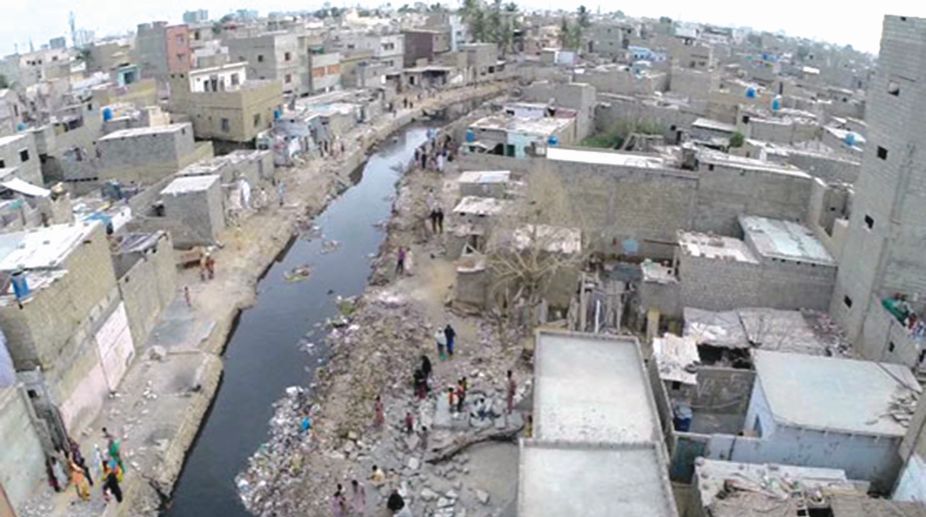Cong defeated ‘Bangladesh’ in semis, will rout ‘Pakistan’ in finals: Reddy
Reddy was addressing a meeting of the Congress social media team and took digs at both the BJP and the BRS.

It’s a common problem faced by every household that is not fortunate enough to have access to what might be called ‘civic services’. It’s a problem if it doesn’t go away. The waste needs to go away, somewhere and somehow.
Most of Pakistan’s cities have sewage systems of some sort, whether the pipelines are old and broken, or going nowhere.
There is a method in the madness to whatever extent. A large part of Karachi, however, finds itself in a novel situation altogether, with an apparently readymade drain right around the corner, obviating the need for land developers to make proper arrangements (arrangements that might somewhat justify the astronomical prices of land there).
On Tuesday, a Pakistan Supreme Court-mandated judicial commission on water and sanitation issues took further exception to the alleged release of raw sewage into the sea from the Defence Housing Authority area.
Advertisement
The head of the commission, retired Supreme Court judge Amir Hani Muslim, wasn’t happy with the fact that despite clear directives at previous hearings, DHA officials failed to turn up, while the Cantonment Board Clifton appeared to be shifting responsibility for the unchecked pollution — or poisoning — on to the DHA.
On May 8, Justice Muslim had directed the DHA to file the original plans of the multi-billion-rupee housing scheme with the commission, as well as the details of the operational and planned sewage treatment plants. Reportedly, he had noticed four points around Seaview beach where untreated sewage was being let into the sea.
Subsequently, after DHA officials insisted that the liquid was from storm-water drains and not sewage, he had asked the Pakistan Council for Research on Water Resources to collect samples for analysis, which concluded that the housing authority and CBC were draining contaminated water directly into the sea.
If these findings are detestable, one has only to visit the beaches off Karachi — from Seaview to Hawkesbay to Sandspit, to French Point — to find evidence of the unchecked poisoning of the ocean.
Of course, Pakistan is not alone in this — sea pollution is a growing worldwide problem — but Karachi is not adding to its laurels by failing in its civic responsibilities. It is hardly inconceivable in this country where the rule of law is largely absent that an entire housing area may have been planned without reference to basic services. And yet, such seems to be the reality.
It is far from the case that DHA may be the only polluter. From West Wharf to Mauripur, there are thousands of small industrial units that are allowed to let untreated waste flow straight into the sea — for the want of a civic structure and the utter lack of regulation.
A couple of years ago, the Sindh administration acceded that some 8,000 tons of solid waste are either dumped or end up in the Karachi harbour every single day. In addition, some 350 gallons of raw sewage or untreated industrial waste flow into the sea every day (and this is without the estimated involvement of high-profile residential areas).
Sea pollution is a terrible thing; worldwide, the problem is so rampant that by some knowledgeable estimates, in another three decades or so, the oceans will contain more plastic than marine life. A distinction is made between polluted water and solid waste, but the end-result contributes to the identical problem of the waters of this blue-green Earth increasingly being rendered poisonous.
Yet, the problem encompasses far more than that, and has an even more direct bearing on the lives of the citizenry. It has been four years since, after Eid celebrations, it was found that upwards of 30 people had drowned off Seaview beach — the city’s most accessible shoreline spot — alone.
The monsoon tides are dangerous, certainly, but even by that standard the number of these deaths was big. The authorities’ answer was to shut the beach off to public use, ban the access of people to an area where their safety could not be guaranteed.
However, the central potential problem was avoided: the possible effects on the currents of gallons upon gallons of additional water (sewage) flowing into the sea, as well as the effect of high-rise buildings along the shore (the foundations of which must architecturally be commensurate with the height of the building). One can only hope that somebody in the city administration’s planning circles is thinking about such regulation, but that certainly does not appear to be the case.
The city of Karachi — much like the rest of the country — appears to wilfully be poisoning itself and cutting off its own support lines for the future. Where the metropolis is killing off one of its major characteristics, Lahore’s generations are growing up on vegetables sown on land contaminated by untreated industrial effluent in the Kasur region. Where matters will end is increasingly clear.
Dawn/ANN.
Advertisement